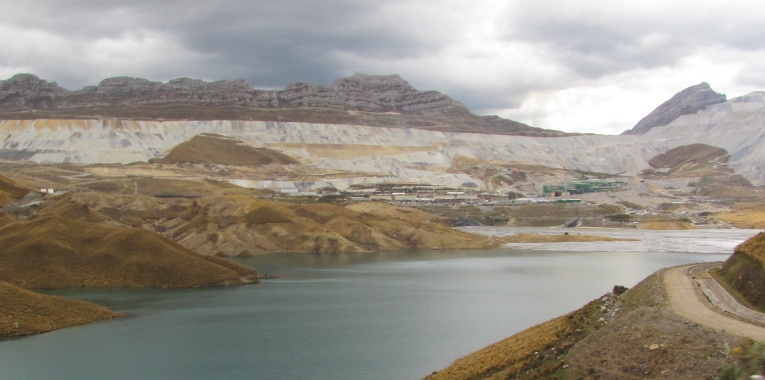For centuries, mining has been an important economic activity for the generation of wealth in Peru. Since the mid-2000s, the commodity boom – which involved the rise of metal prices at a global level – has enhanced the relevance of mining activities within the national economy, representing about 15% of the annual GDP. This has translated to an average 5.5% economic growth rate during these last two decades. Rather than facing the resource trap – whereby countries that depend on an abundance of natural resources may experience economic contraction due to international market price volatility – Peru took advantage of the favourable economic conditions. It partly used that wealth to foster sustainable development and improve living standards around mining areas. However, the socioeconomic benefits, such as “reducing poverty in half and improving income distribution” have been limited mainly because of the government’s systemic mismanagement of resources. The continuous growth of the informal economy and the rise of illicit economic activity, such as the illegal extraction and export of gold, the below-standards working conditions, and the impairing of water quality in rivers near mining areas, has demonstrated the government apparatus’ inability to adapt and respond with effective measures to ensure wealth redistribution and sustainability.
Now, Peru faces a deadly virus and an equally deadly economic crash as “GDP plunged 30.2% from a year earlier”. Peru’s reputation as a low-risk country for foreign investment has been damaged. The country no longer enjoys the successful economic liberalisation and stabilisation that they did in the 1990s and that became the bedrock for sustained economic growth. So, the question lingers: who or what can lead Peru out of this crisis and promote socio-economic development for the years to come?
I expect the mining sector to consolidate its place as the main engine of growth in Peru’s economy in spite of the coronavirus pandemic. The return of mining activity in Peru has already been able to mitigate some negative impacts caused by the pandemic: the government believes it will restore 68,000 direct jobs in mining areas and many more indirectly through supply chains and administration work in urban areas. Therefore, when attempting to further socio-economic development in Peru, the mining industry provides the most obvious path forward.
In fact, the mining industry in Peru was and still is a popular destination for foreign direct investment (FDI): in terms of FDI mining stock, the number has remained constant throughout 2018 and 2019 averaging $6.018 billion. Yet, FDI inflows only favour multinational corporations if the government fails to direct these investments. Future policies should focus on upgrading the country’s infrastructure needs and fostering economic linkages to create positive spill-overs in other sectors of the economy. As such, while Peru’s investment policy framework allows “foreign and national investors to have equal access to investment incentives”, it does not promote private investments in infrastructure or technical education programs to improve skilled labour.
There are two future scenarios for the mining industry that could occur in the short term. Either way, the Peruvian government should prioritise the mining industry’s recovery as this will cause a ripple effect in other areas of the economy. One approach could be a wave of deregulation and incentivisation to boost private investment in the mining sector, most likely at the expense of environmental standards and communities’ rights. This option would follow the flexible neoliberal tide that has been guiding Peru’s economic policy for the last 15 years or more. Stand-out policies include easing the process of obtaining permits to work and reducing the power of the Organismo de Evaluación y Fiscalización Ambiental which imposed sanctions on companies that violated environmental standards. However, a contrasting scenario could see greater government intervention to safeguard mining communities. Although this would entail an ideological and paradigm shift from the government, it would monitor social conflicts effectively and potentially encourage the local distribution of income or royalties from extractive activities.
As such, there will be obstacles that Peruvian mining will face during its recovery. By relying on commodity markets, the volatility of global demand could be damaging and force Peru to fall into the resource trap. Also, the government will have to keep an eye on large Chinese public investments in infrastructure which may prop up the price of copper and zinc; two minerals that are abundant in Peru and make up most of its exports. Another significant challenge includes fixing the government’s mismanagement of resources and inability to manage investment projects effectively. A study by Proetica outlining the risks of corruption in the Peruvian mining sector identified that while the population is not opposed to mining investments, they resist new projects due to the “lack of transparency in information and asymmetry of power that exists when a concession is granted without involving the communities’ land owners, whose lives will be impacted by the mining activity”. The government’s disregard for local communities while excessively favouring mining operators through FDI incentives is another reason for the population’s distrust of local authorities.
Having said this, there are notable opportunities to remodel and build a framework that outlines the Peruvian government’s desired relationship with mining multinational corporations in order to promote socio-economic development and economic growth in Peru. The state has an inherent role to curb multinationals’ operations and foreign investments, while maintaining a friendly and attractive investment environment. For the mining industry, the government needs to provide a ‘middle-way’ operating structure. It should create a mix between neoliberal policies and government intervention to harness the benefits of multinational corporations and utilize economic growth as a step towards socio-economic development rather than identify the former as the ultimate end goal. The Peruvian government should form ‘adaptive partnerships’ with multinational mining corporations and manage FDI through an improved version of ‘Obras por impuesto’ (Works for Taxes Law) first enacted in 2008, to effectively increase the implementation of public infrastructure projects across the country. This, in turn, could help mend the gap in the Peruvian state’s approach, where investments in infrastructure and education to improve the labour force have been neglected for years. However, various scholars have highlighted normative gaps in the practical application of this law, including issues with permits to implement investment projects and missing clauses regarding, for instance, what happens to the social project if it encounters local resistance. These are key legal aspects that need to be addressed in order to enhance the efficiency of this mechanism.
While all this entails an overhaul of how the Peruvian government operates and their goals in the long-term, it is a policy proposal within their reach. If Peru does not follow this framework with the right means to achieve it now, there might not be a next chance to do so for the years to come.
Paula Arrus
Paula is a third year International Relations student and Working Group Member of the Business and Economics Policy Centre. She is from Peru with a strong interest in Latin American politics and economics and enjoys writing thought-provoking pieces about the future of our world. She is very interested in exploring how multinational corporations can promote socio economic development around the world, particularly in the mining industry.
The featured image (top) is ‘Mina Antamina vista desde el sureste’ from 2012. The image is by Ondando and is licensed under Attribution-ShareAlike 3.0 Unported (CC BY-SA 3.0).
Bibliography
Alves, B. Mining sector as percentage of total exports in Peru from 2010 to 2019, (9 July 2020). Retrieved from Statista: https://www.statista.com/statistics/1030692/peru-mining-sector-share-total-exports/
América Economía. Perú apuesta a la minería para superar crisis económica por la pandemia del Covid-19, (14 May 2020) Retrieved from América Economía: https://www.americaeconomia.com/negocios-industrias/peru-apuesta-la-mineria-para-superar-crisis-economica-por-la-pandemia-del-covid
BCRP. ACTIVIDAD ECONÓMICA: ABRIL 2020 RESUMEN. NOTAS DE ESTUDIOS DEL BCRP., (2020) Retrieved 31/10/2020, from https://www.bcrp.gob.pe/docs/Publicaciones/Notas-Estudios/2020/nota-de-estudios-44-2020.pdf
CEIC Data. Peru Foreign Direct Investment: Stock: Mining, (2019). Retrieved from CEIC Data: https://www.ceicdata.com/en/peru/foreign-direct-investment-by-industry/foreign-direct-investment-stock-mining
de la Flor, P. Mining and Economic Development in Peru. ReVista: Harvard Review of Latin America, (2014). Retrieved from ReVista: Harvard Review of Latin America: https://revista.drclas.harvard.edu/book/mining-and-economic-development-peru
Dent, C. ‘Transnational capital, the state and foreign economic policy: Singapore, South Korea and Taiwan’. Review of International Political Economy, (2003), 246-277.
Focus Economics. Peru Economic Outlook, (14 July 2020). Retrieved from Focus Economics: https://www.focus-economics.com/countries/peru#:~:text=Due%20to%20favorable%20conditions%20in,exports%20of%205.5%25%20since%202000.
Herkenrath, M., & Bornschier, V. ‘Transnational Corporations in World Development – Still the Same Harmful Effects in an Increasingly Globalized World Economy?’ Journal of World-Systems Research, (2003), 105-139.
Ministerio de Energía y Minas. La importancia de la minería en el Perú. Lima: Ministerio de Energía y Minas (2013).
Moreno, L. Peruvian police pacts with Chinese mining company threaten to undermine state authority, (4 May 2020). Retrieved from Diálogo Chino: https://dialogochino.net/en/extractive-industries/35155-peruvian-police-pact-with-chinese-mining-company-threaten-state-authority/
Proetica. CORRUPTION RISKS IN THE MINING SECTOR: PERU REPORT. Lima: PROETICA, National Council for Public Ethics, (2019).
Quigley, J. Peru Leads Global Economic Crash With 30.2% Quarterly Drop, (20 August 2020). Retrieved from Bloomberg: https://www.bloomberg.com/news/articles/2020-08-20/peru-leads-regional-economic-crash-with-30-2-quarterly-drop
ScienceDaily. Gold mining critically impairs water quality in rivers across Peruvian biodiversity hotspot, (11 November 2019). Retrieved from Science Daily: https://www.sciencedaily.com/releases/2019/11/191111180056.htm#:~:text=A%20new%20study%20finds%20that,rivers%20near%20the%20mining%20sites
United Nations Conference on Trade and Development. Investment Policy Review Peru. Geneva: UNITED NATIONS PUBLICATIONS, (2000).
Valle-Riestra, E., & Ramírez, T. MINERÍA, PANDEMIA Y REGULACIÓN.
Oportunidades de cambio en el sector minero. Lima: Grupo Propuesta Ciudadana, (2020).
Zúñiga, L. GAPS IN THE PUBLIC WORKS TAX DEDUCTION LAW AND ITS PRACTICAL APPLICATION. Themis: Revista de Derecho, 65, (2014), 293-302.

